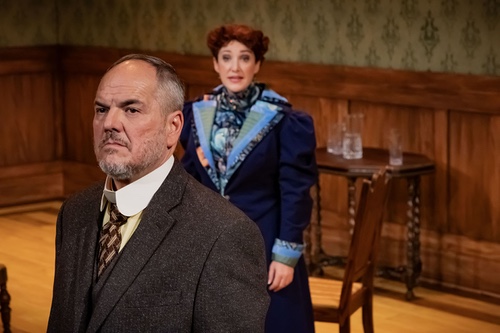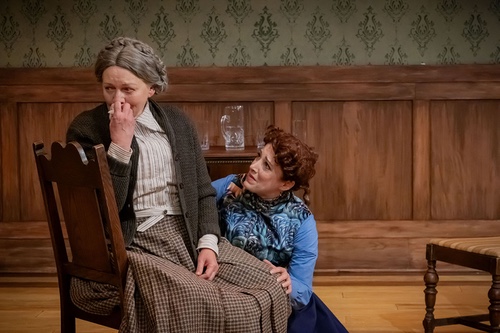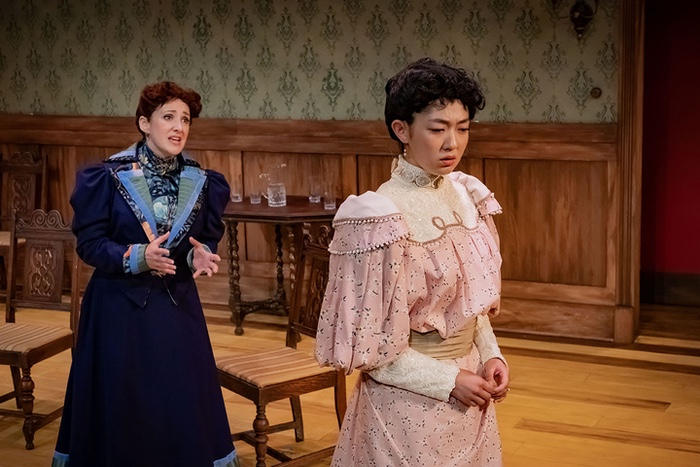Through June 30
And—she’s back! Wham.
“She” in this case is Nora, the unhappy wife and mother who resigned her post, slamming the door behind her, in Henrik Ibsen’s A Doll’s House (1879). Now, in playwright Lucas Hnath’s “A Doll’s House, Part 2,” (2017), we find out what happened.
Fifteen years have passed. When the play opens, we hear Nora (Anjanette Hall) knocking on the door. She has returned. She wants something.
The last time I saw Ibsen’s original A Doll’s House in a Mamai Theatre production in 2017 Anjanette Hall ruled as Nora, so it was amusing to see Hall playing (convincingly and consistently) Nora once more.
Nora is greeted cautiously by skeptical housekeeper Anne Marie (Nanna Ingvarsson) who wonders (and asks rudely) how Nora’s been supporting herself. Nora toys with Anne Marie a bit before telling. Nora also meets her now-grown daughter, Emmy (Tabitha Raithel) and discovers Emmy can yell as indignantly as her mother Nora.
Next, Nora’s husband Torvald (a sympathetic David Vegh) appears. The two review their past, fairly peacefully, but the door still bangs shut at the end.
While director Donald Carrier knows Nora’s assertive ways (and Hall captures them with confidence), the play seemed heavy with loud lectures about how life should be conducted. Worse, this production seemed to ignore much of the subtle situational (often ironic) humor Hnath wove into the play.
An example? Nora teases housekeeper Anne Marie by asking her “How do you think I made a living?” Several wrong guesses later, Nora triumphantly reveals that she is a best-selling novelist — of course, under another name. (A common practice then — and now — for female authors.) Nora’s response should make any experienced writer in the audience smile wryly (or at least it did this one), since most writers would be hard-pressed to live off their fiction-writing income.

The set, designed by Jill Davis, offers touches of 19th-century décor, but primarily features a large, bare floor. This means the characters spend (sometimes too much) time moving a few chairs around as they speak to each other. Thanks to sound designer Angie Hays we can hear everything everyone says, but at times the actors seem to be shouting when they don’t need to. It’s a small stage, after all.
That said, lighting designer Adam Ditzel and costume designer Jenniver Sparano contributed to turning the small Studio Theater space into a suggestion of an elegant mansion from a distant era.
BOTTOM LINE: If you’ve ever wondered what happened after Nora left her home — the house where she felt like a doll in a doll’s house — this play has some answers. Hnath’s Nora reminds me of Barbie in the recent film. And like Barbie, it takes Nora a while to find the answers. But this version, 90 minutes with no intermission, lacks the humor that saved Miz Barbie’s adventure from being yet another lecture about what one should do based on one’s socially-determined role.


2 Responses to “THEATER REVIEW: “A Doll’s House, Part 2” @ Beck Center by Laura Kennelly”
Donna M. Shimko
I saw ‘Doll’s House 2’ last weekend, and was bitterly disappointed. The opening, with the ominous knocking, was perfect – but! I found the cursing (and I do love a good swearing session!) to be gratuitous and did not work – when you’re doing a period piece, using modern language patterns just doesn’t make sense. Strong language could have been chosen and would have made this play much, much stronger. Nora’s and Torvald’s discussion of their plight was repetitive and led nowhere. I don’t think Nora would have gotten into a situation as the playwright imagines. Even her scenes with her daughter were weak – no strong or resolute emotions were shown. To do a sequel to an iconic play is daring and difficult – but this ‘Doll’s House 2’ needs rewriting or to be relegated to the attic.
Laura Kennelly
Thank you for the comment. I wonder if it’s simply more difficult for some to realize the essential nature of “housekeeping” and “moming?” At any rate, we’ll have to write our own play, I guess.